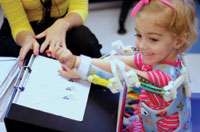August 6, 2012 weblog
Movement-limited toddler gets 3-D-printed magic arms (w/ Video)

(Phys.org) -- A disabled toddler suffering from Arthrogryposis Multiplex Congenita (AMC) is able to pick up objects and play, not only thanks to her research team of doctors at the Nemours/duPont Hospital for Children but thanks to the technology of 3-D printing, which enabled her to use a magical arms device to move freely for the first time.
Her 3-D printed device is based on the Wilmington Robotic Exoskeleton (WREX), an orthopedic apparatus made from hinged bars and resistance bands. The WREX is described as an anti-gravity upper limb orthosis. The WREX was constructed to help children with little residual strength from muscular and joint disorders to move their arms in space. The problem was that, while WREX was able to help arthrogryposis sufferers as young as six years old, the child in this case study, Emma, was only two and weighed twenty-six pounds.
The device was too heavy and bulky for her to manage easily. Development, even with WREX, would still be a challenge. The medical team on Emma’s case turned to what they knew about and had available in 3-D printing, which they put to use to suit Emma.
They used a Dimension SST 1200es 3D printer and Stratasys production system. so as to create a prosthetic light enough for young Emma to continue moving around freely.
The toddler was now able to lift her arms and pick up objects for the first time in her life. Her parents say that her very first sentence was the say that she wanted her magic arms. The Stratsys system makes use of medical-grade materials that contributed to the success of the device. The ABS plastic material for the magic-arms device was described as “human friendly, strong, and durable.”
Most important, using a robust 3-D printing technology means that doctors can rely on a system to accommodate wide-ranging specifications for patients. In the case of Emma, the use of 3-D printing will allow the doctors to keep adjusting her prosthetic; it will evolve as she grows.
“Without the 3-D printer we would not be able to make devices for children,” said one member of Emma’s team. He noted that in the area of prosthetics for children, “we need ‘custom everything.’” Creating a lightweight exoskeleton by hand would be extremely difficult, and 3-D printing technology enabled the researchers to customize WREX to exact specifications.
Neuromuscular disabilities and orthopedic disorders in children include muscular dystrophy, spinal muscular atrophy, AMC, scoliosis, spinal cord injury, and leg length discrepancies. AMC is a rare congenital disorder that sees the muscles and joints shortened and muscles weakened.
More information: Stratasys
© 2012 Phys.org


















